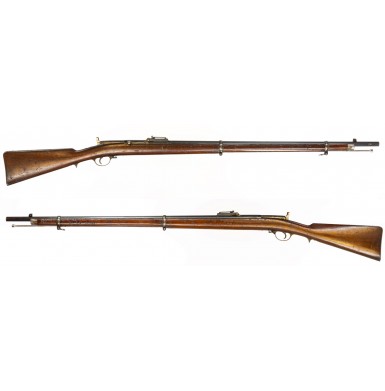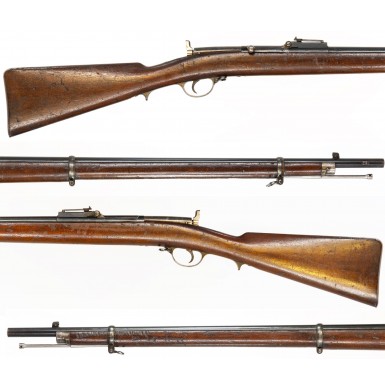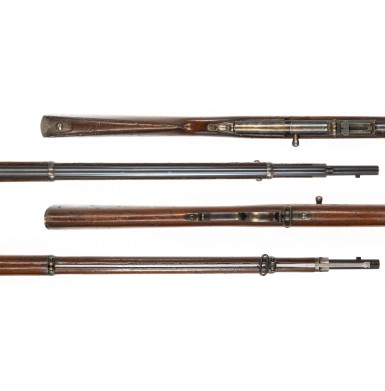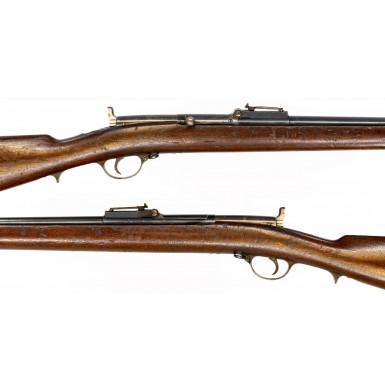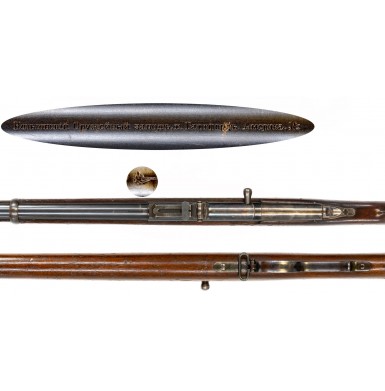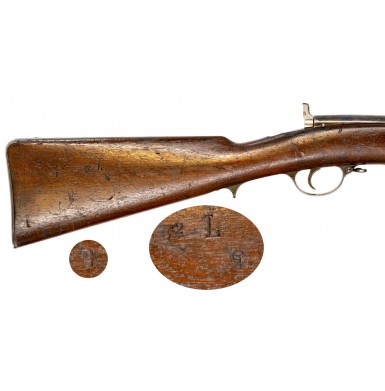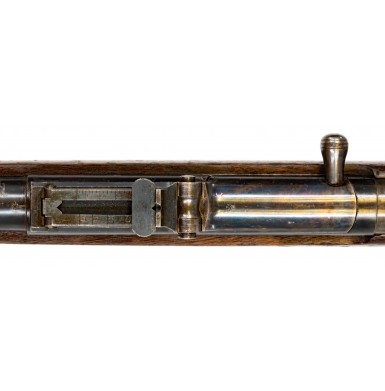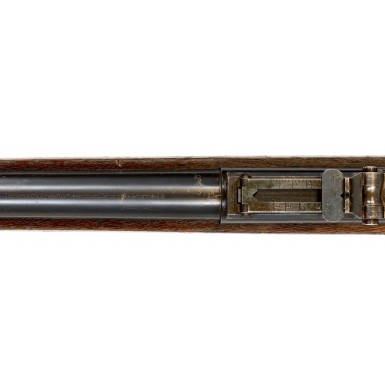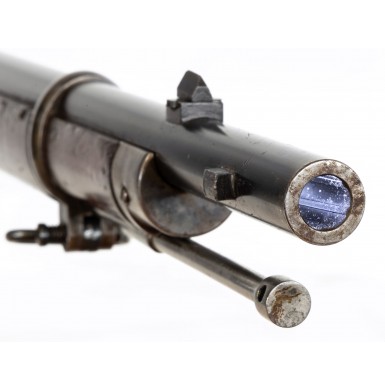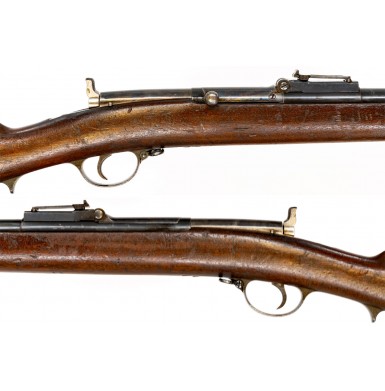Excellent and Rare Colt Russian Model 1868 Berdan I Rifle
- Product Code: FLA-3958-SOLD
- Availability: Out Of Stock
-
$11,950.00
The end of the American Civil War in April of 1865 and the resulting abrupt cancellation of nearly all outstanding and current military contracts by the US Government placed many of America’s gunmakers on shaky ground financially. Those that had entered the business when the war started, in hopes of making quick profits, were among the first to fail. With no established market presence prior to the war and no manufacturing capabilities beyond US model rifle muskets or special patent carbines and revolver, many of these firms quickly went out of business. More established gunmakers like the Starr Arms Company of Yonkers New York, who had been making arms for the government prior to the outbreak of the war, managed to hold on briefly but were often out of business by 1867 or 1868 when new contracts did not materialize.
The Colt Patent Firearms Company was in a somewhat better position that most gunmakers, in that they had been in business for more than a decade prior to the war in their current incarnation and had established a strong following in the civilian market with their high-quality percussion revolvers. They had deep market penetration, a strong reputation in the field and excellent name recognition. What they did not have was a product for the rapidly changing field of modern firearms design. The American Civil War had clearly shown that the days of percussion, muzzle loading arms were over, and that the new world was one of guns that fired self-contained metallic cartridges. This was problematic for Colt since they primarily manufactured handguns, and their largest competitor Smith & Wesson controlled the patent necessary to make an effective and efficient cartridge revolver. Smith & Wesson held the exclusive rights to the Rollin White patent for the bored-through cylinder and without access to that patent, which would not expire until 1869, Colt was forced to try to find ways to produce cartridge revolvers that evaded that patent. Their less than successful Thuer line of cartridge revolvers was a good example of their attempts to stay relevant in the handgun market, as they watched the sales of their previous market flagship percussion revolvers like the Model 1849 Pocket, Model 1851 Navy, and Model 1860 Army plummet. Colt’s position in the rifle market was even weaker, and nearly non-existent. During the Civil War the only longarms that Colt had produced were some of the Model 1855 Root patent side hammer guns and the Special Model 1861 Rifle Musket. There was now no demand at all for a muzzleloading percussion rifle musket and Colt needed something to offer to the market.
Elisha Root had started working on a metallic cartridge rifle design towards the end of 1864, but at the conclusion of the war he was not materially past the experimental and model stage. The firm did manage to secure some percussion revolver business after the conclusion of the war through their London agent Baron Von Oppen. In the fall of 1865, Von Oppen had managed to sell some Colt Model 1851 Navy Revolvers to the Viceroy of Egypt and in so doing also opened the door to sell surplus Colt Special Model Rifle Muskets that the firm had on hand. The Viceroy only wanted the muskets if they were altered to breechloading metallic cartridge arms and eventually a deal was struck to sell 12,100 Special Model Rifle Muskets to Viceroy after they were altered to the Snider Breechloading system. The acquisition of the machinery to produce the parts needed for the Snider system put Colt in the breechloading metallic cartridge market, but they continued to search for a better product to offer. One of their in-house designers, Alexander Thuer did develop a sliding block breechloading metallic cartridge design that never got past the development and sample stage, but it showed the firm was clearly making efforts towards that end.
Colt was keeping their options open and as a result started looking at outside designers. In the fall of 1866 Major T.T.S. Laidley approached Colt about producing sample rifles based upon a rolling block design that he and C.A. Emery had invented. Although sample rifles were produced, they did not result in any further contracts or commercial interest for Colt, although a few years later Whitney ended up incorporating Laidley’s improvements into their line of rolling block rifles. Another outside design was that of Lewis Lippoldt, who developed an improved version of Root’s experimental breechloading design. However, after some initial development and samples, this design was abandoned by Colt.
By mid-1867 pressure was increasing for Colt to have a viable breechloading rifle design in the market. Colt had been working with a number of foreign countries to win military contracts to produce long arms and had yet to be successful. They had bid on a contract to produce the Model 1866 Chassepot Rifle for France and had not been selected. They had similarly chased a potential Austrian contract to produce Werndl Rifles and again had not received it. In the case of the Werndl contract this was particularly galling, as the firm had invested in the machinery to produce the Werndl action. There was also pressure from an old time Colt customer, Russia. Colt had contracted to sell rifled percussion muskets to the Russians during the Crimean War, and although the war had ended abruptly and resulted in the contract being cancelled with only about 3,000 of the guns delivered, Colt hoped that this time the result would be different.
Enter Colonel Hiram Berdan. Berdan was certainly well-known in post-Civil War America and throughout much of the world as the namesake of the two regiments of Berdan Sharpshooter’s that he organized during the Civil War. To most who simply knew his name he was a “war hero” but to those who dealt directly with him on a regular basis, adjectives like “ruthlessly ambitious”, “arrogant” and a “supreme egotist” were all used and likely quite appropriate. Berdan was brilliant, even if he was difficult to work with, and not the war hero that popular culture makes him out to be.
Berdan was born on 6 September 1824 in the town of Phelps in Ontario County New York. As he grew up, he had two passions: inventing and shooting. By the time he was 23 he had received his first patent for a threshing machine and before he reached the age of 28, he received a patent for a “gold amalgamation machine” which could separate gold from quarts. As this was the height of the California Gold Rush period, his invention made him extremely wealthy very quickly. He was also a top marksman and widely known target shooter. In 1861, it was Berdan who sold the concept of a regiment of designated marksmen to the US military, a harkening back to the days of the British Army’s “rifle regiments”. Berdan established grueling standards for the men that were recruited to serve in these specialized units and soon organized two full regiments of the finest shots in the north, which the War Department designated the 1st and 2nd US Sharpshooters. However, they will forever be known as Berdan’s Sharpshooters. While Berdan was an excellent shot and a brilliant inventor he was not a good military commander. By the fall of 1862 charges of “conduct unbecoming an officer”, “abandoning his command” and “cowardice” were swirling around him. In fact, he was described as “incompetent” by General Fitz John Porter. Although he was initially found “not guilty” of the charges, the case was later reexamined and he was found to be guilty, putting an end to his military career in January 1864. At this time, he returned to his other love, inventing. He soon received a patent for a self-contained centerfire metallic cartridge, and cartridges that use this system are still referred to as the Berdan Primed to this day.
Berdan’s involvement with the Colt Patent Firearms Company really started to be serious in the fall of 1866. At the time he was working on breechloading rifle designs, both with an eye to producing a way to alter muzzleloading arms to breechloaders and as a standalone design as well. Between October of 1866 and January of 1867 Berdan approached Colt to estimate the costs and potentially pursue the production of 60,000 Enfield Rifle Muskets altered to Berdan breechloaders for the Canadians, 50,000 of the same for the State of New York, for the production of 300,000 Berdan breechblocks for Spain, as well as machinery to make them and for the potential of altering 100,000 additional muskets “abroad” to the Berdan system. Based upon the notes taken of their meetings by Colt President Major General William B. Franklin, we know that after getting his quote for the Canadian and New York Berdan altered Enfield contracts, that Berdan sought a quote from Remington and then proceeded to use that to try to get a better price from Colt. In the end those contracts went to Remington, who produced the guns using the samples built by Colt. But Franklin saw the potential for Berdan to bring significant business to the company and continued to put up with his eccentricities and generally gruff attitude.
Berdan’s design, like nearly all of the widely accepted breechloading designs of the mid-to-late 1860s revolved around a hinged breechblock. In all Berdan would experiment with three different hinged breech designs at Colt, the first being an articulated two-piece breech and the next two utilizing solid breech blocks. The hinged system made it easy to utilize both as a standalone system and to alter existing muzzleloaders to breechloader. The hinged breechblock contained a firing pin which was struck by a spring-loaded in-line striker in the rear of the action. The system was rather advanced and modern in that it did not utilize a hammer to strike the firing pin. The striker which struck the firing pin entered the rear of the breech block when the gun was fired and locked the breechblock in the close position. When the cocking piece was drawn back to the cocked position, it disengaged from the breechblock and allowed it to be opened. Opening the action activated the extractor and ejected the fired cartridge casing. A new cartridge could then be placed in the chamber, the action closed, and the rifle was ready to shoot. While Berdan’s design did not infringe upon Erskine Allin’s patent for the Trapdoor rifle system since Allin’s system was predicated on the alteration of pre-existing receivers to accept the new breechblock, rather than using a newly made receiver, it did infringe at least partially upon some other existing patents. Patents by General Benjamin Roberts, George & William Miller and Mont Storm were all at least lightly touched upon in Berdan’s design. As a result, Colt made sure to secure the patent rights to all of these designs for the production run of the Model 1868 Rifles.
While the design of the gun is generally credited to Berdan, surviving records and notes suggest that the two Russian military representatives involved in the contracting process with Colt had at least some influence upon the rifle’s design. Russian Captain K.I, Gunius and Colonel Alexander P Gorlov are believed to have made as many as twenty-five design suggestions during the process and there is the possibility that they may have been responsible for the adoption of the in-line striker system and the abandonment of the conventional hammer in the design.
The Berdan I Infantry Rifle as adopted by the Russians utilized Berdan’s .42 caliber Berdan primed cartridge, which would become known as the 10.66x57R (or 10.75x57R) cartridge, and as the 4.2 Line cartridge in Russia. The nickname was derived from the caliber of the cartridge and the Russian unit of measure, the “liniya”, which was 1/10 of a diuym. A diuym had been established as being equal to an English inch by Peter the Great, thus a liniya was one tenth of an inch, and four liniya was 4.2 tenths of an inch or .42 caliber. The cartridge featured a paper patched round nosed 99% lead and 1% antimony bullet that weighed 386 grains over a propellant charge of 77 grains. The cartridge had a nominal velocity of 1,440 ft/s and a muzzle energy of roughly 1,770 foot/pounds. The cartridge certainly held its own with all of the comparable military cartridges of the period and was essentially the basis for the .43 Spanish cartridge which would see use worldwide for a number of decades.
The rifle had a nominally 32.5” round barrel secured by two screw clamping barrel bands, an overall length of 53” and weighted in at nominally 9 ¼ pounds. The rifle was equipped with an adjustable ladder rear sight, a dovetailed blade front sight in a rectangular base and had a lug on the left side of the barrel to guide the mounting of socket bayonet. Sling swivels were attached to the upper barrel band and the front of the triggerguard bow. A rudimentary pistol grip projection was included at the rear of the trigger plate. A steel cleaning rod was included in a channel under the barrel. The barrels of the guns and most of the furniture was blued, while the receivers were color casehardened, as were the buttplates. Markings were limited to a one-line barrel mark in Cyrillic which essentially translated to read “Colt Arms Factory City of Hartford America No” or “Colt’s Armoires, Hartford, America No” with the serial number applied by the Russians after receipt of the rifle, following the abbreviation for the word number. It appears that initially these rifles were intended for use by specialized riflemen or sharpshooters with the majority of the line infantry being armed with the cartridge altered Krnka rifles. As a result, the order was only for 30,000 rifles. Deliveries began during early 1869, as the official final variant of the rifle was not approved until February of 1868 and the necessary machinery was installed and able to produce the guns on the assembly line until December of 1868. The 30,000 rifles were delivered in several batches between March 1869 and May 1870.
Almost as soon as the ink was drying on the contract for the 30,000 Berdan I Rifles, Hiram Berdan was trying to improve upon his design. The next incarnation of the Berdan design was as a single shot bolt action rifle that utilized the same cartridge. This rifle was adopted by the Russians as the Model 1870 or Berdan II rifle. However, other than the samples and some of the machinery necessary to produce the guns, the production was all performed by Russian state arsenals like Tula, Izhevsk and Sestroretsk rather than by Colt. Some Berdan II Rifles were also produced in Great Britain by BSA. Despite the fact that the Berdan I Rifles were obsolete almost as soon as they were being adopted and were officially replaced by the Berdan II Rifles only two years after they were first accepted into service, the rifles remained in service through the Great War period, although typically in reserve and rear echelon applications.
Offered here is an EXCELLENT condition example of a Colt Russian Model 1868 Berdan I Infantry Rifle. The rifle remains in wonderful condition and retains most of the original factory finish. The barrel retains about 92%+ of the original blued finish with some thinning, light wear, and loss due to age and handling. The metal is smooth and free of pitting with some scattered minor impact marks present on the barrel. The receiver retains a similar amount of the original vivid mottled color casehardened finish, again showing some minor thinning and dulling to the vibrant colors. The furniture shows the greatest amount of finish wear and loss with the buttplate showing moderate loss and the triggerguard showing some light to moderate thinning. The metal remains clearly and crisply marked with the one-line Cyrillic barrel marking reading:
Кольтовскiй Оружейный заводЪ. г. ГартфордЪ. Америка No.
This translates to read Colt Arms Factory City of Hartford America No but no serial number was applied after the abbreviation for “number”. As the serial numbers were hand stamped by the Russians after acceptance in Russia, the lack of serial number suggests that this was either a sample rifle that was never delivered or possibly a sample rifle that was delivered but never issued for service in Russia. In either case, the fact that the gun bears Cyrillic markings and is in America makes it extremely rare, as usually the only Colt Berdan I Rifles encountered in America have standard English markings. The only other markings are some stampings in the obverse buttstock which may be Russian inspection marks. These marks include what appears to be a {Russian Eagle}, the number “2” stamped twice and slightly over stamped and the letter L. Another mark in the stock is not immediately legible but resembles an “H”. The action of the rifle is fully functional and the cocking, firing and breech locking mechanisms all function crisply and correctly. The bore of the rifle remains in EXCELLENT condition as well and is bright and shiny with some minor frosting and crisp six-groove rifling. The rifle retains its original long range military ladder rear sight, the original front sight, the original cleaning rod and both sling swivels. The stock of the rifle rates about FINE but shows more wear than the balance of the rifle. The stock is solid and full-length with no breaks, cracks, or repairs. The wood shows a moderate number of scattered bumps, dings, and mars, as well as an area of additional minor dings and impact marks along the forend on the reverse, running from the nosecap to about 3” behind the upper barrel band. Despite the wear and mars on the stock, the gun really remains in fantastic condition and retains nearly all of the original finish.
Overall, this is a really exceptional example of a very scarce and extremely high condition Colt Russian Model 1868 Berdan I Infantry Rifle. As noted, the gun remains in original condition with most of the original finish and clear original Cyrillic markings. With only 30,000 of these guns produced circa 1868-1870 they are extremely rare in their own right, as few managed to survive the field service in multiple Russian wars, including World War I and the Russian Revolution. While it can be argued that the Berdan I rifles were not the “first Russian military cartridge rifles” since they were developed concurrently with the Krnka breechloading alteration rifles, it can be honestly said that it was the first Russian military rifle adopted that was a metallic cartridge rifle from its inception. The cartridge was one of the more advanced military cartridges of the period and remained in service with the Russian Model 1870 Berdan II Rifle through the World War II period. While English-marked Berdan I rifles occasionally appear for sale in the United States, those guns that were truly part of the Russian production run that are marked in Cyrillic practically never do. This is a simply stunning condition example of an extremely rare gun that is an important piece of both Colt firearms and Russian military arms history. It represents the first non-conversion metallic cartridge long arm to be produced by Colt and the first purpose built Russian military cartridge rifle. The exceptional condition and rarity of this rifle qualifies it to be a centerpiece in any advanced collection Colt firearms or Russian military firearms. It could be years before another Cyrillic-marked Colt Russian Model 1868 Berdan I Infantry Rifle is offered for sale again in the United States, and chances are it will not be in such wonderful condition.
SOLD
Tags: Excellent, and, Rare, Colt, Russian, Model, 1868, Berdan, I, Rifle


